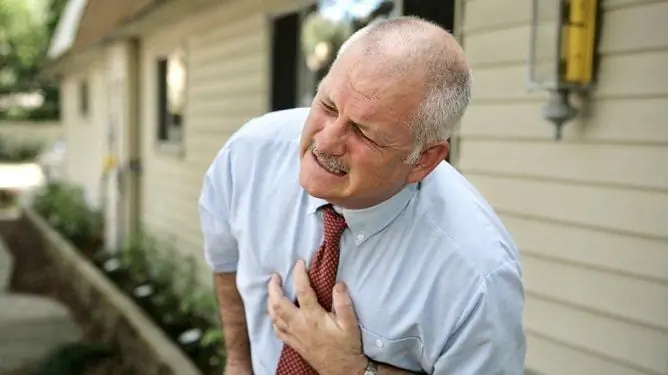Table of contents:
- Signs of a heart attack in women: symptoms and precursors
- Harbingers of myocardial infarction
- The first signs of myocardial infarction in women
- Features of the course of a heart attack in women
- Risk factors for developing heart attack in women
- Causes of a heart attack
- Video

Video: Signs Of A Heart Attack In A Woman: Symptoms, How It Manifests Itself, What To Do

2024 Author: Rachel Wainwright | [email protected]. Last modified: 2023-12-15 07:39
Signs of a heart attack in women: symptoms and precursors
The content of the article:
- Harbingers of myocardial infarction
- The first signs of myocardial infarction in women
- Features of the course of a heart attack in women
- Risk factors for developing heart attack in women
- Causes of a heart attack
- Video
Signs of a heart attack in women can have features that make it difficult to diagnose. Myocardial infarction is an acute heart disease, which is accompanied by the death of cells in the heart muscle due to the cessation of blood supply in it. Dead cells are replaced by connective tissue, due to which the functions of the heart muscle are not fully restored. It is important to know the signs of a heart attack in order to recognize it as quickly as possible and provide the right assistance - a person's life may depend on this.
Harbingers of myocardial infarction
How to recognize a high risk of developing a heart attack long before it occurs?
There are a number of clinical signs due to which it is possible to determine the approach of a cardiovascular catastrophe.

Harbingers of heart attack are often mistaken for malaise
In most women who have had an acute myocardial infarction, about 25-30 days before the attack, the precursors of the disease appeared:
- chronic fatigue syndrome - increased fatigue, lack of energy, which is not removed even by prolonged rest. Over time, unreasonable fatigue gets worse;
- shallow or intermittent sleep, insomnia;
- snoring during sleep, apnea;
- swelling of the legs, feet and hands, caused by impaired blood flow and poor cardiac activity. Numbness or tingling sensation in the extremities;
- pain in the stomach, frequent upsets of the gastrointestinal tract for no apparent reason - this symptom is explained by the fact that the diaphragm and digestive organs are close to the heart muscle. Thus, with the defeat of the lower parts of the posterior wall of the ventricle of the heart, pain is given precisely to this area;
- short bouts of unexplained anxiety;
- frequent headaches, episodes of visual impairment;
- bleeding and soreness of the gums caused by impaired blood supply to peripheral vessels;
- Difficulty trying to take a deep breath or shortness of breath with little exercise. The feeling of shortness of breath goes away after rest;
- heart palpitations, arrhythmia - consequences of the development of heart failure or coronary artery disease;
- increased urge to urinate at night;
- discomfort in the chest, in the region of the heart - patients have a feeling similar to a muscle strain.
Harbingers of a possible heart attack are usually fleeting, they appear and disappear on their own.
The first signs of myocardial infarction in women
When a cardiovascular attack begins, it manifests itself with rather severe symptoms. The most characteristic sign of an impending acute heart attack, which can be used as a test, is the appearance of acute, compressive chest pain that lasts more than 15-20 minutes and does not go away after taking analgesics or nitroglycerin. Such pain can radiate to the back, neck, arms or shoulders, and the lower jaw. This phenomenon is called anginal status and manifests itself in 95% of cases in patients over 40 years of age.
In addition to burning chest pain, typical signs of a heart attack include:
- shortness of breath, feeling of suffocation;
- numbness of the left side (arm, leg, neck);
- dry and painful cough;
- nausea, vomiting;
- feeling short of breath;
- decrease or increase in pressure;
- violation of visual function;
- excitement of the nervous system;
- weakness, pallor of the skin, dizziness;
- unaccountable fear of death;
- cold, clammy sweat caused by significant amounts of stress hormones that the adrenal glands release into the bloodstream.
Often, the symptoms of a heart attack in women are atypical or vague, indistinct. Signs of a heart attack in women in women over 50 years old can be disguised as an exacerbation of pancreatitis (nausea, vomiting, heartburn), an attack of arrhythmias, bronchospasm, neurological disorders (neurosis, confused speech, blurred consciousness, impaired coordination of movements), flu or a cold.
Sometimes a heart attack in women is practically asymptomatic, in such cases, the patient may not experience severe pain, write off the weakened condition for osteochondrosis, pressure surges or general malaise. The absence of cardiac pain during a heart attack is especially common in patients with diabetes mellitus.
What to do if these symptoms occur in yourself or loved ones? While at home, you must first call an ambulance, since the treatment of a heart attack at home is not allowed, and if timely first aid is not provided, the consequences may be irreversible.

The first thing to do when signs of a heart attack appear is to call an ambulance.
Features of the course of a heart attack in women
There are some features of the course of myocardial infarction in women:
- pain is not as intense as in men. Often, cardiac pain in women with a heart attack is not acute, but pulling and aching. It is believed that a higher pain threshold may be the reason;
- pain in the stomach - this symptom is rarely found in men and is explained by the fact that the digestive organs in the female body are located close to the heart muscle;
- pain in the arms, back, neck, jaws. Pain in women often radiates.
The study of the dynamics of morbidity showed that mortality from myocardial infarction among women was 9%, while among men - only 4%. The probability of death in the first few hours after a massive heart attack in women of young (under 30) and middle (over 35) age is 68% higher than in men of the same age group.
Risk factors for developing heart attack in women
There are known factors that contribute to the development of myocardial infarction in women. They are associated with the structural features of the body and lifestyle in girls and women. Among them:
- heart structure: the female heart is on average slightly smaller than the male. The mass of a woman's heart is 200-300 g, that of a man's - 270-380 g;
- vascular structure: the lumen of arteries, including coronary arteries, is much smaller in women. This contributes to an increased pressure of blood flow to the walls of blood vessels and a more intense deposition of cholesterol;
- increased formation of atherosclerotic plaques and their localization: as a rule, in women, atherosclerosis often affects small vessels;
- a higher incidence of diseases that contribute to the onset of a heart attack, in particular, diabetes mellitus;
- higher prevalence of obesity.
In another group, you can combine risk factors for the development of a heart attack, which are relevant not only for women, but also for men:
- hereditary predisposition;
- elevated blood lipids;
- bad habits, in particular smoking;
- sedentary lifestyle;
- elevated homocysteine levels;
- excess weight;
- high blood pressure;
- psychosocial factors, stress instability.
Most often, excessive nervous tension, stress, high physical activity, fluctuations in atmospheric pressure, vascular (often hypertensive) crises become a direct impetus to myocardial infarction, less often - surgery, hypothermia. What pressure can trigger a heart attack? A dangerous value for blood pressure is considered to be numbers above 140/90 mm Hg. Art.
Causes of a heart attack
What causes a heart attack? The narrowing of the lumen of the coronary arteries leads to a decrease in blood flow to any part of the muscular layer of the heart (myocardium), a weakening or complete cessation of the blood supply to the heart muscle occurs, and coronary heart disease develops. An acute form of ischemic heart disease, which occurs with the development of cardiac cell necrosis, is called myocardial infarction.

The cause of a heart attack is a violation of the blood supply to the heart muscle
The main role in the development of a heart attack belongs to pathological processes in the coronary arteries of the heart: narrowing of their walls, vascular spasms, loss of elasticity, atherosclerotic changes.
In most cases, the disease develops against the background of atherosclerosis. The appearance of atherosclerotic plaques and hemorrhage causes narrowing or complete closure of the vessel lumen, often this process is accompanied by the appearance of blood clots.
How old can a heart attack be? According to statistics, myocardial infarction in women at a young age is much less common than in men. This is due to the fact that estrogens produced in a woman's body have a beneficial effect on vasodilation and the work of the muscular layer of the heart, have an antioxidant, cardioprotective and antiatherogenic effect. However, with the onset of menopause, estrogen production is significantly reduced, the risk of developing the disease increases significantly, the incidence rate in women in old age (over 60 years old) is compared with that in men.
Video
We offer for viewing a video on the topic of the article.

Anna Kozlova Medical journalist About the author
Education: Rostov State Medical University, specialty "General Medicine".
Found a mistake in the text? Select it and press Ctrl + Enter.
Recommended:
First Aid For A Heart Attack: Signs Of A Heart Attack, What To Do?

Myocardial infarction is an emergency that occurs due to an acute violation of the blood supply to the heart muscle
Symptoms Of Sinusitis In Adults: The First Signs, How It Manifests Itself, Photo

The main symptoms of sinusitis in adults are nasal congestion, headache, fever, local signs of inflammation and deterioration of the general condition
Signs Of A Heart Attack In Men: The First Symptoms Of Myocardial Infarction, Causes

Timely recognition of the signs of a heart attack in men significantly increases the chances of a favorable outcome - the earlier treatment is started, the more successful it is
Signs Of A Heart Attack: The First Symptoms, How To Recognize A Heart Attack Without A Doctor

To provide timely assistance, it is necessary to know well the signs of myocardial infarction, as well as the emergency care algorithm
Signs Of Eye Pressure In Adults: How Elevated IOP Manifests Itself

Signs of increased eye pressure should not be ignored, as this condition may indicate serious medical conditions






